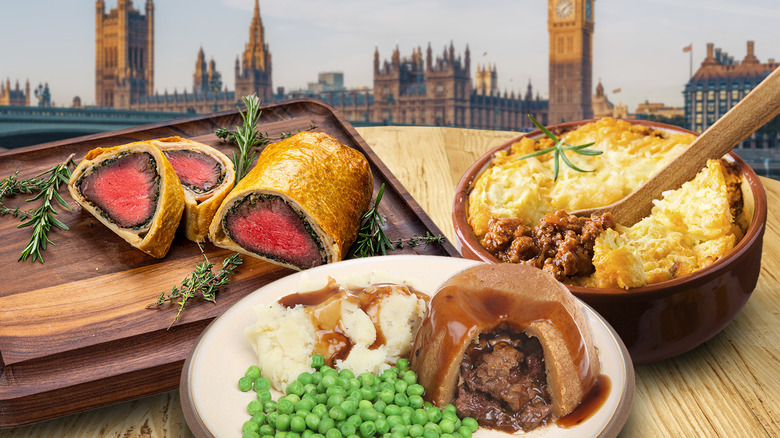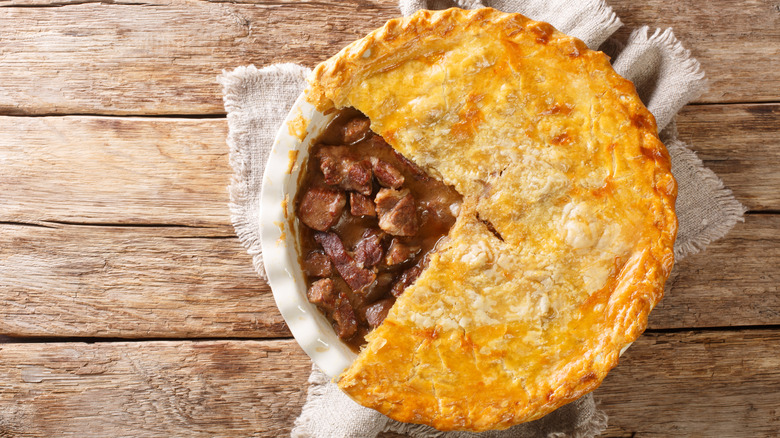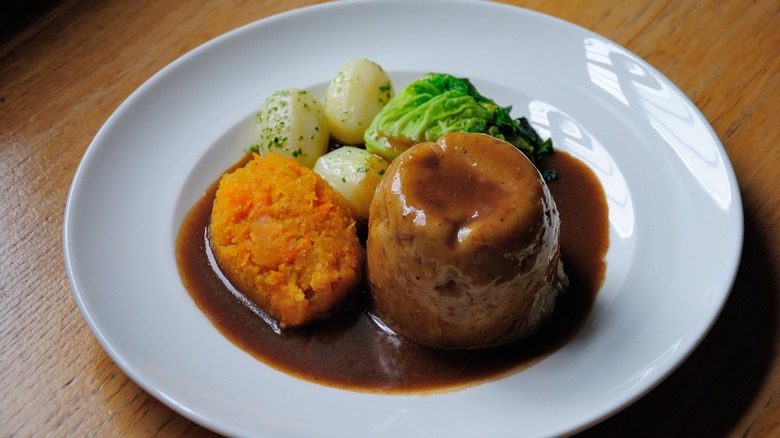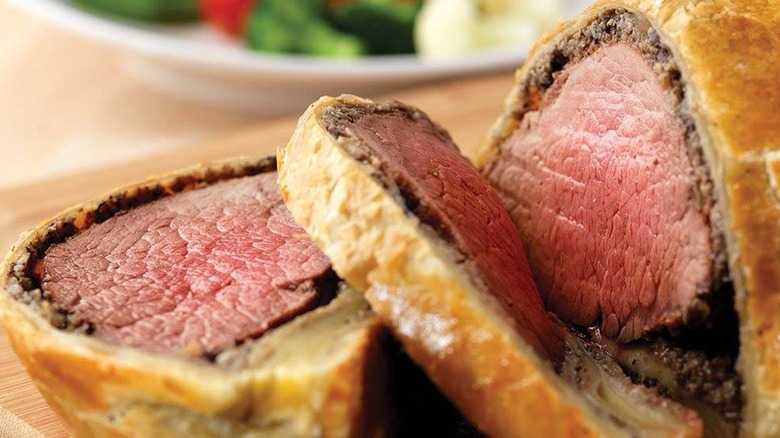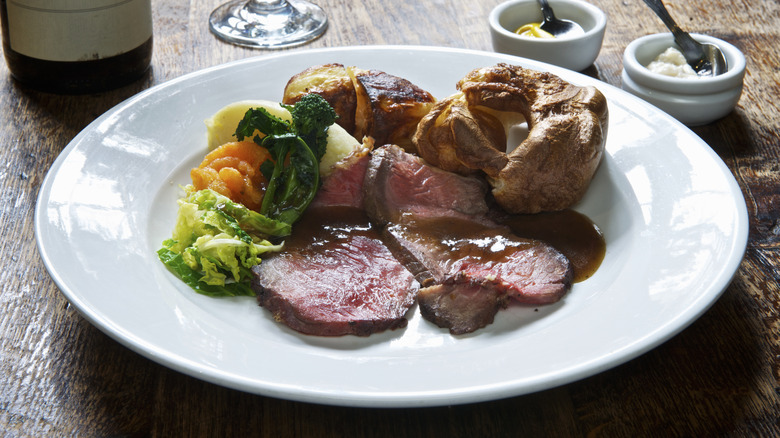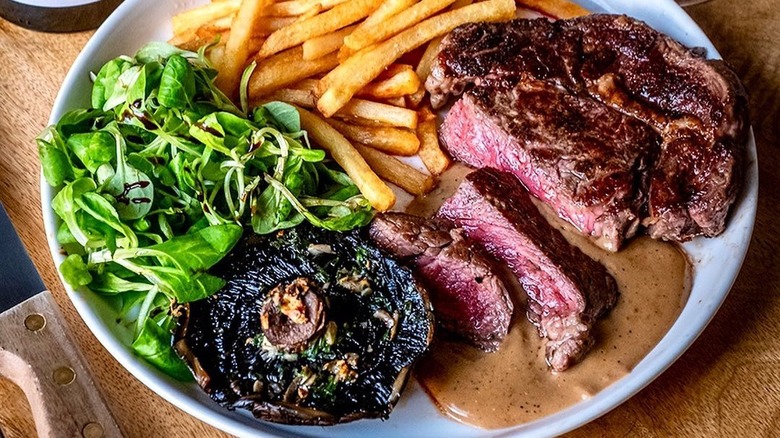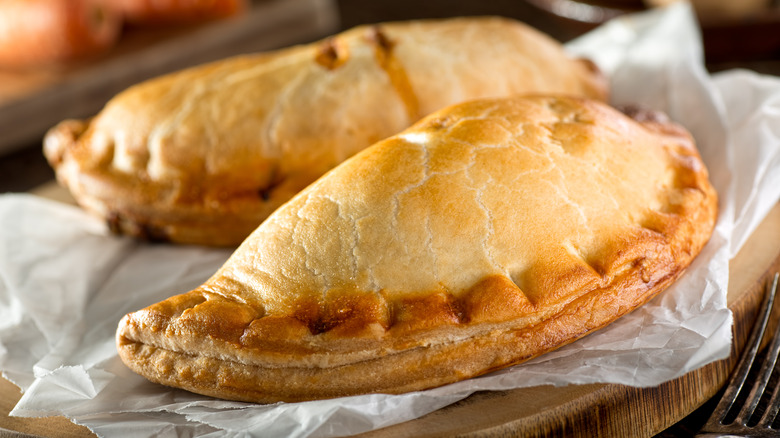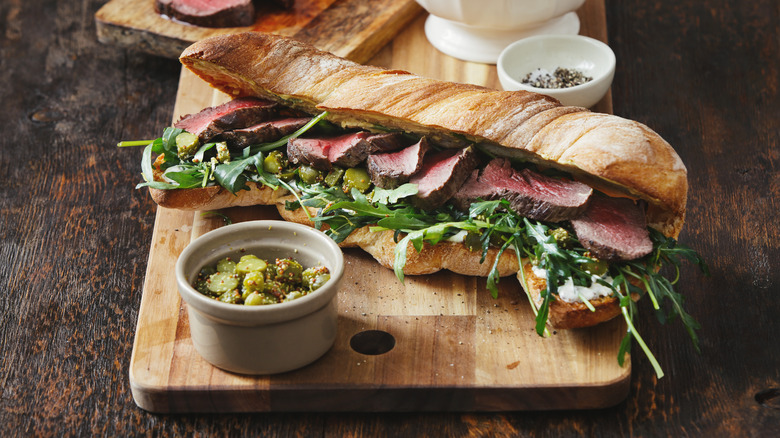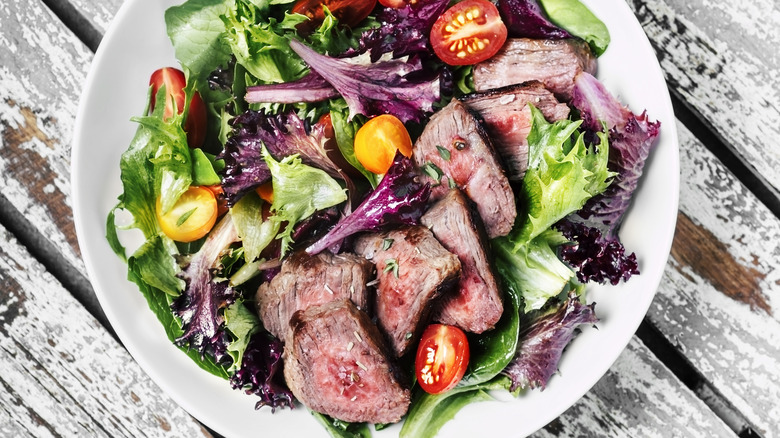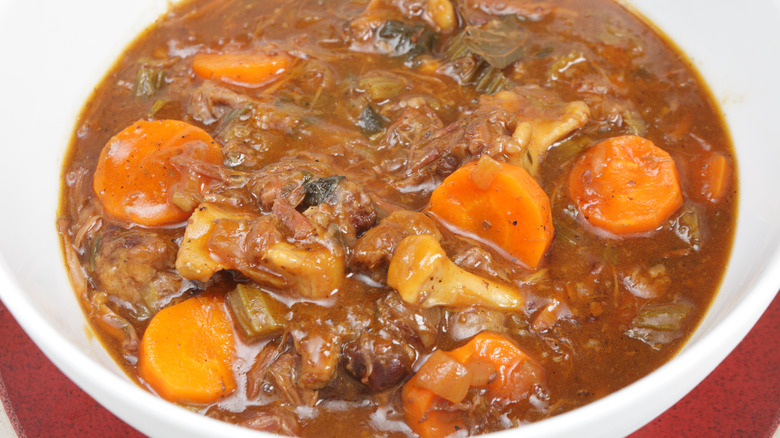10 Classic Steak Dishes You'd Find In The UK
Steak doesn't only have to be enjoyed as one juicy slab of meat on a plate. This beloved sliced beef is also fantastic for incorporating into a range of delicious home-cooked dishes. And when it comes to steak-based delights, the Brits have got it right. From traditional stews to indulgent pies, British steak dishes have a prominent spot in the nation's dining culture.
Have you ever sliced into the flaky crust of a steak and ale pie or enjoyed the savory satisfaction of a beef Wellington? Whether it's enrobed in pastry, slowly simmered in a flavorful broth, or served as part of a hearty roast, steak fits seamlessly into a diverse range of British classics. While some dishes, like the Cornish pasty, trace back to centuries-old working-class traditions, others, such as the steak salad, often demonstrate a modern twist by pairing the meat with fresh and colorful ingredients.
This list of steak dishes truly highlights the diversity of British cuisine, showcasing 10 mouth-watering recipes that are frequently enjoyed at home dinner tables, pubs, and restaurants alike. We'll explore the unique qualities of these iconic meals, as well as their origins, how they're prepared, and what you can expect if you're keen to give them a try. If you're a meat lover with a penchant for comfort food, this guide is for you.
Steak and ale pie
A staple in British pubs, steak and ale pie is the ultimate comfort food. This savory dish combines tender pieces of steak with a hearty ale-infused gravy, all encased in a golden, flaky pastry. It's a meal that's warming, filling, and flavorful — everything you could want in a pie! The key to perfecting this dish is ensuring the filling is slow-cooked to really let those flavors meld. Steak cuts like chuck or beef shin work best here, and they're simmered gently until the meat is melt-in-your-mouth tender. The ale should be a dark brew that's slightly on the sweeter side, to add a wonderful malty depth that really enhances the meat's flavor.
Traditionally, the pie is topped with a shortcrust or puff pastry lid, which is baked until crisp. Some recipes even use rich suet pastry for an extra element of indulgence. Vegetables like onions, carrots, and mushrooms can be added, too, for extra nutrition and heartiness.
While popular on U.K. pub and restaurant menus, it's also a popular homemade meal, often prepared for family gatherings or Sunday dinners. Steak and ale pie is usually served with a side of mashed potatoes or thick-cut chips, along with greens like broccoli or peas, so on the whole, it can be a pretty well-rounded meal. However you like to eat it, it's a dish that's sure to warm you up on even the coldest of British days!
Steak and kidney pudding
Steak and kidney pudding might not sound like the most appealing of dishes to many, but considering it's been around since the 1860s, it can most certainly be considered a classic. So, how has this strange offal-filled "pudding" stood the test of time?
Despite the name, steak and kidney pudding is very much a savory dish, and thankfully, not an attempt to shoehorn steak into a dessert. Unlike steak and ale pie, which has a flaky crust, this dish is made with a suet pastry that is soft, moist, and usually steamed rather than baked. Inside, you'll find a hearty filling of diced steak, onions, and lamb or ox kidney cooked in a luscious gravy. The kidneys add a unique iron-rich bitterness that can be considered an acquired taste to some, but there's no doubt that this dish is deeply flavorful.
To make a proper steak and kidney pudding, the suet pastry is used to line a pudding basin, then filled with the meat and gravy mixture. More pastry creates a lid to seal everything inside, and the pudding is then steamed for several hours, allowing the flavors to develop while the pastry shell becomes tender. The result is a dish that's super cozy and satisfying. The pudding can be served with mashed potatoes, steamed vegetables, and extra gravy on the side for good measure.
Beef Wellington
Perhaps the most decadent on this list, beef Wellington perfectly combines elegance with indulgence. This iconic meal centers around a prime cut of beef fillet, which is seasoned and seared to seal in the juices. The beef is then coated in a layer of pâté or a finely chopped mushroom mixture known as duxelles. Some traditional recipes use thin pancakes to wrap the pate or duxelles around the beef, though using prosciutto or Parma ham is now more common. The whole masterpiece is then wrapped in puff pastry and baked until golden, creating a dish that's visually impressive yet hearty and delicious.
The history of beef Wellington is somewhat mysterious, with competing theories about its origin. Some claim it was named in honor of the Duke of Wellington, while others say it's an adaptation of the French "filet de boeuf en croûte." Regardless of its origins, beef Wellington is a firm British favorite. Due to its lengthy and meticulous prep time, it's often reserved for special occasions and makes a popular centerpiece during the holiday season.
A perfectly executed beef Wellington should have crisp, golden pastry with no sogginess, and the beef itself should remain tender and succulent, usually served medium-rare. Though its impressive presentation and rich flavors are sure to take center stage, this dish can be served with an assortment of sides. Sauteed garlicky green beans, roasted Brussels sprouts and asparagus, potatoes au gratin, and honey-glazed carrots would all make excellent accompaniments.
Roast beef
It may sound like a basic concept, but roast beef is a dish that the British pride themselves on getting just right. It has graced Sunday dinner tables for centuries, with its simplicity and comforting savory flavors making it the ultimate crowd-pleasing family meal. Roast beef is typically made with a tender cut, like rib or sirloin. This is usually coated with some simple seasonings, like herbs or mustard powder. Then, the beef is roasted in the oven until the outer layer is browned and caramelized while remaining juicy and tender inside.
The tradition of roast beef dates back to the reign of King Henry VII, who frequently devoured this meat with his guards, establishing the "Sunday roast" as a defining part of English cuisine. Though the beef itself is the main event, it's often served with Yorkshire puddings — fluffy, airy accompaniments made from batter, which are ideal for soaking up the juices. Alongside, you'll usually find a medley of roasted vegetables like potatoes, carrots, and parsnips, adding color and goodness to the plate. And, of course, a well-cooked roast beef dinner isn't complete without gravy. This is often made with the roasting juices from the meat to make the most of those moreish beefy flavors.
The meal is a favorite for those from multiple generations, frequently served during gatherings and holiday feasts. With its satisfying simplicity, it's the perfect way to celebrate the natural richness of a good-quality cut of beef.
Steak and chips
Another dish that seems simple in theory, steak and chips is a British favorite that focuses on quality ingredients, cooked well. But executing it perfectly can be challenging. Choosing the right cut of steak and nailing the cooking times and techniques are essential if you don't want soggy chips or tough steak. This dish pairs a juicy steak with golden, crispy chips (better known as "fries" across the pond), and it's often enjoyed in pubs and steakhouses, and is cooked by meat lovers across the U.K.
The cut of steak can vary, with pricier ribeye or fillet often being the gold standard, though sirloin or rump can produce equally flavorful results when cooked well. The steak is typically seasoned with just salt and pepper, then seared or grilled to the diner's preference — rare, medium, well-done, or somewhere in between. To make the chips, thick slices of white potato are usually parboiled and deep-fried until golden. The "triple-cooked chips" technique is also a favorite amongst restaurants and "gastropubs," where the potatoes are first boiled, frozen, and then deep-fried twice. This was a technique first developed by Michelin-starred chef Heston Blumenthal, and it results in chips that are extra crispy on the outside, yet wonderfully fluffy in the middle.
Steak and chips is often accompanied by a variety of sauces, with peppercorn, bearnaise, and garlic butter being popular choices. You might also find it served with a side of mushrooms, creamed spinach, or grilled tomatoes to round out the meal.
Cornish pasty
The Cornish pasty is a handheld pie that originated in Cornwall in the 1700s. This traditional pastry was originally crafted to serve as a portable, filling meal for Cornish miners. Modern recipes typically opt for a savory filling, but early versions were often filled partially with meat and partially with fruit to form a handy dinner and dessert in one. The Cornish pasty has a thick, crimped crust, which not only helps to seal in the fillings, but once also provides a handle for miners with dirty hands to hold and discard after eating the rest of the pasty.
Inside a classic Cornish pasty, you'll find a savory mixture of diced beef, potatoes, swede (aka rutabaga), and onions, all seasoned simply with salt and pepper. These ingredients are wrapped in a sturdy shortcrust pastry, which keeps the filling juicy and flavorful during baking. It's a simple combination of ingredients that work together in a rather harmonious way, with each bite containing the perfect balance of buttery pastry and hearty filling.
Today, the Cornish pasty remains popular U.K.-wide, found at bakeries, food stalls, cafes, and supermarkets. While there are many variations with different fillings like chicken, pork, or even vegetarian-friendly twists, traditionalists would argue that only the classic beef and vegetable combination is a true Cornish pasty. Often enjoyed as a lunch or a snack, the pasty is a recognizable symbol of Cornwall's culinary heritage and a fantastic example of British ingenuity.
Beef stew with dumplings
This next dish is certainly one that fits into the comfort food category. Beef stew with dumplings is the kind of meal that's made for chilly weather, with tender pieces of beef simmered slowly alongside root vegetables in a savory flavor-packed broth. Braising or stewing beef are the cuts typically used here, as they become wonderfully tender and juicy when cooked low and slow.
And, of course, there are the dumplings — a key element of this British classic. These are soft, pillowy balls made by mixing suet, flour, and water into a smooth dough. Some recipes will also recommend adding herbs to the dumplings for extra flavor, while others keep it simple, allowing the beef and vegetables to shine. The dumplings are shaped and added towards the end of cooking. As they steam on top of the stew, they soak up the broth's savory flavors whilst staying nice and fluffy inside. Beef stew with dumplings can either be made in a large pot on the stovetop or in a slow cooker. Served in a deep bowl, often with a side of crusty bread for dipping, this dish is perfect for sharing around the family table. It's a popular wintertime dinner in the U.K., often enjoyed on cozy nights in, and much-loved for its nourishing feel.
Steak sandwich
Philly cheesesteak move aside — there's a new take on the classic steak-bread combo to try. The steak sandwich is an option you'll often find on pub and cafe menus in the U.K., allowing you to ditch the steak knives by turning this much-loved meat into something you can eat with your hands. This dish generally features slices of juicy, well-seasoned steak served between slices of fresh, crusty bread or ciabatta. It's portable, satisfying, and easy to customize, too. The cut of steak can vary, but sirloin is a popular choice for its tender and flavorful nature. The meat is first seared or grilled before resting and slicing it thinly to fit snuggly into the sandwich.
A great steak sandwich is all about the right accompaniments, and there are no set rules when it comes to elevating it with your favorite toppings. Caramelized onions, tomatoes, melted cheese, and fresh arugula or watercress are all common additions that can complement the richness of the meat brilliantly. Some people add a smear of mustard or horseradish for a spicy kick, while others prefer the creaminess of mayonnaise or garlic aioli. For an added layer of flavor, the bread can be toasted or grilled, giving a satisfying crunch.
In a restaurant, a steak sandwich might come with a side of chips, crisps, or a light salad and can be served for either lunch or dinner. Of course, it's easy enough to whip up as a quick yet indulgent meal at home, too.
Steak salad
Steak salad brings a refreshing twist to the traditional ways of serving steak in British cooking, and it's another dish that comes with plenty of room for adaptation. Combining thinly sliced, seared steak with a vibrant mix of greens and veggies, this dish is a lighter yet still super satisfying option for steak lovers.
After choosing the most suitable cut of steak, the meat is first seasoned or marinated. Spices like cumin, paprika, and garlic powder are fantastic for enhancing the flavors of the beef, though you can, of course, keep things simple with the classic salt and pepper. Next, the steak is grilled or pan-seared, then sliced thinly before adding it on top of the salad. A classic steak salad will typically include a blend of fresh greens. This could be arugula, watercress, lettuce, or spinach, with their fresh, peppery notes contrasting that meaty steak wonderfully. Additional ingredients might include radish, cherry tomatoes, fresh herbs, or roasted vegetables, adding plenty of color and texture. Some versions incorporate crumbled cheese like goat cheese or Stilton or even toasted nuts for added crunch.
For the dressing, a light balsamic vinaigrette can keep things fresh, perhaps enhanced with a splash of lemon or a spoonful of horseradish. Or, for something more indulgent, a creamy option like a cilantro and lime dressing can be delicious, too. Steak salad makes a perfect light lunch or dinner, especially during warmer weather, and it's often prepared as a side dish for summer barbecues.
Oxtail stew
This flavor-loaded, slow-cooked dish is another warming stew that's deemed a nostalgic staple by many Brits. Oxtail stew brings out the best in an affordable cut of meat — the tail of the cow. Whilst this bone-in cut is typically tough, when oxtail is cooked low and slow, it becomes amazingly succulent and tender. Cook it correctly, and the meat should be falling off the bone.
The stew's base typically includes onions, carrots, and celery, with additional ingredients like garlic, thyme, and bay leaves enhancing its flavor. The oxtail is usually browned before adding it to the stew, by searing it in oil. Coating the meat in flour prior to searing can also help to achieve a perfectly caramelized outer layer. Next, the oxtail is simmered with the broth and vegetables for several hours, allowing the connective tissues to break down and impart a silky richness to the broth. Some recipes call for a splash of red wine or stout to deepen the flavor, while others add tomatoes or Worcestershire sauce for added tang. Oxtail stew can be served with mashed potatoes, crusty bread, or even dumplings for added rustic charm.
Oxtail is also rich in collagen, which is one of the key contributors to this stew's unique, full-bodied flavor. Collagen also helps to thicken the broth naturally as it's released during cooking, and consuming it may provide a range of health benefits. Studies have demonstrated collagen's positive effects on the skin, hair, bones, and joints.
